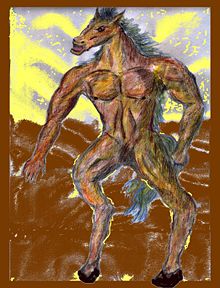Tikbalang
Tikbalang (/ ˈtikbaˌlaŋ /) (also Tigbalang , Tigbalan , Tikbalan , Tigbolan ) is a Filipino legendary figure who is said to live in the forests and mountains of the Philippines . It is a large, bony human-like figure with a horse's head and hooves and disproportionately long limbs, so that when crouching, the knees reach over the head.
origin
The traces of Tikbalang go back 4000 years. The indigenous people of the Philippines believed in animism . In 1589, at the beginning of the Spanish occupation, father Juan de Plasencia documented the importance of Tikbalang for the local population. The Hinduism spread in the 2nd century along the trade routes from India to Southeast Asia. Tikbalang may have emerged from Hayagriva , an avatar of the Hindu god Vishnu.
Taming a Tikbalang
A tikbalang is said to have a mane of pointed spines, with the three thickest spines of the mane having a special meaning. If you manage to get one of these three spikes, you can use it as a talisman against getting older and thus keep the tikbalang in check. To do this, the tikbalang must be overpowered by jumping on its back and tying it with a special rope. The budding Tikbalang tamer must then remain on his back while the creature flies through the air and tries with wild leaps to get rid of the unwelcome rider until it gets tired and admits its defeat.
literature
- Neal Cruz: As I See It: Philippine mythological monsters . In: Philippine Daily Inquirer , October 31, 2008.
- Keith Thompson's portrayal of a tikbalang
Individual evidence
- ^ Philippine Folk Literature: An Anthology, Eugenio Damiana, University of the Philippines Press, 2007, ISBN 978-971-542-536-0
- ^ El Folk-Lore Filipino, Isabelo De Los Reyes Y Florentino and Isabelo De Los Reyes, 1995, ISBN 978-971-542-038-9
- ↑ Jordan Clark: Tikbalang: The Horse Demon , Episode 1, Creatures Of Philippine Mythology (2015), https://www.youtube.com/watch?v=gRUSBSJ39KY
- ↑ https://www.aswangproject.com/tikbalang-documentary/
- ^ El Folk-Lore Filipino, Isabelo De Los Reyes Y Florentino and Isabelo De Los Reyes, 1995, ISBN 978-971-542-038-9

